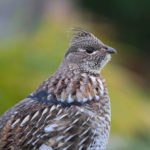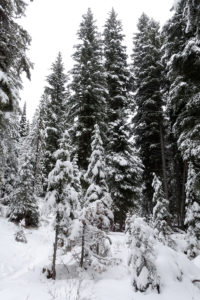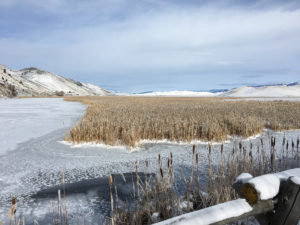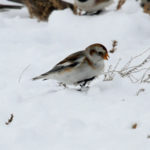By Frances Clark – Lead Ambassador, Nature Mapping Jackson Hole
Habitats and Wildlife in Winter
Wildlife habitat has changed drastically with the onset of freezing temperatures, deep snow, and short days—winter! Plants adapt by losing leaves (except for evergreens), storing starch underground, and altering physiology of cells. The landscape is primarily brown and white, with little lush green. Food and cover are scarce. Consequently, animals that don’t migrate alter their behaviors, even metabolisms, to survive. Adaptations to winter are fascinating to contemplate and observe.
Here are a few interactions that Nature Mappers can map and all can enjoy!
Dry Hillsides
Look for Townsend’s Solitaires amidst Rocky Mountain Junipers that dot the dry slopes and ledges of buttes. Townsend’s Solitaires are a bit smaller than robins, mostly gray but with a white eye-ring and a touch of orange on their wings, which is most visible when they fly. Look up their sounds that can alert you to their presence. They can survive the winter eating silvery juniper berries (actually cones) that contain a high level of lipids, carbohydrates, and some protein. Birds are also protected from chilling winds by the thick branches. Fruit-eating Bohemian and Cedar Waxwings may also drop in and share the bounty.
Aspen Groves
Both snowshoe hares and Ruffed Grouse burrow in snow for warmth and safety and eat woody plants for food. Great Horned Owls and Northern Goshawks predate them both. A tough life.
Ruffed Grouse feature a crest of head feathers and a banded tail. They often perch on limbs of aspen trees, nibbling buds, but are very hard to see. Before aspens shed their leaves in the fall, the plants transport reserves of food and nutrients into their twigs and buds as well as roots for growth next spring. Consequently, aspen buds are relatively nutritious, but hard-to-digest, winter food. Grouse have adapted to eating this material by first consuming large amounts quickly, storing the buds in their crop, and later in a safe warm burrow of snow, digesting it slowly through an extended intestinal system.
Sometimes, we hikers and skiers (and our dogs) flush up grouse from where they lay insulated by snow.
Also, look for tracks of snowshoe hares. These elusive members of the lagomorph family browse on woody plants including aspens and pines. They too have the challenge of digesting this tough diet. As with all members of the family (rabbits and pika), the most fibrous material passes on through the digestive tract quickly, but the richer material is held back in a special chamber called a cecum. In this large pouch, bacteria and other microorganisms go to work breaking down the complex compounds. After several hours, this bacteria-infused matter is excreted as “night feces” and is then quickly eaten again. As these soft, pre-processed pellets pass through the stomach and intestines once more, the food value is extracted. The visible results are dry pellets. You may see them deposited just outside the snow burrows of hares.
Tracks of snowshoe hare can also hop into evergreen forests.
Evergreen Forest:
Evergreen forests—with their diverse “structure”, evergreen needles, and plentiful cones–provide cover and food for a variety of birds, small mammals, and some larger critters, such as moose and deer.
Skiing through a forest, you might spook up a Dusky Grouse. Similar in size to its cousin the Ruffed Grouse, Dusky Grouse is mottled grayish to brown with undefined tail markings. If you are lucky, you may spy the orange crest over the eye of the male. This species feeds primarily on buds and twigs of evergreens. Their chicken-like tracks can be obvious in snow.
It is easy to know if a red squirrel is present by it vociferous defense of its midden of cones. But look also for tracks or a glimpse of a Pacific marten, its main predator. Martens use branches and fallen trunks as their highways.
In the calm of snow-clad evergreens, you may suddenly hear a flurry of birds. Several different species arrive in “irruptive” flocks looking for food that is lacking in their homeland. Often species are intermixed: mixed flocks.

Cassin’s Finch by Susan Marsh
Red-breasted Nuthatches, with their nasal calls, glean insects from rough bark or needle bunches. Red Crossbills sweep into patches of favored cones, using their twisted bills to pry open cone scales, their spoon-like tongues to scoop the seed, and special “throat pockets” to hold the seeds until they can settle to eat. Other small forest birds can include Cassin’s Finches, Pine Siskins, and Dark-eyed Juncos. Many of these same birds may alight at a bird feeder near you.
Chickadees are not exclusive to the forest, but exemplify how small birds have adapted to extreme cold. Chickadees can stash hundreds of individual seeds and remember where they put them for over a month. They know if a seed has been taken by another and won’t waste time looking for it. Groups of 8-10 defend these storage areas with their constant chatter, signaling their dominance. These tiny birds, which weigh about the same as 2 nickels, add 10% of their body weight in fat each day and burn it up overnight to stay warm.
Energy-saving strategies include fluffing their feathers, hiding their heads under their wings, dropping their daytime body temperature by 5-11˚F, increasing their respiration rate, and even shivering to stay sufficiently warm. Chickadees can reduce their body temperature even more to 50˚F, but such a state of torpor prevents them from responding to a predator, such as a weasel or owl. And finally, chickadees may huddle together at night. Amazing. Common Redpolls, Pine Siskins, Ruby-crowned Kinglets, Red Crossbills, and White-crowned Sparrows use a variety of these same strategies.
Wetlands:
Most of our marshes, swamps, and small waterways freeze solid in winter limiting habitat of water-dependent animals.
Still, you may spy a hole where muskrats emerge onto the ice and munch a bunch of rhizomes. These 2- to 4-pound “rat-tailed” rodents must find over a pound a day of starchy rhizomes: cattails, pond lilies, rushes, or sedges to survive. They typically search within 150’ of their dens, which are built into the side of ponds, marshes, or oxbows.
If you happen to come across a beaver dam, think about the beaver family snug in their lodge. Can you see steam coming out of the ventilation hole at the top? Imagine 40- to 50-pound adults swimming underwater for up to 15 minutes to retrieve willow stems from their winter stash. The bark and wood is a diet full of cellulose. To digest this fibrous fare, they have a similar hindgut fermentation process to snowshoe hares. And if they have limited food and it’s super cold, beavers can drop their body temperature to about 34˚F to save energy! And muskrats may come huddle a beaver family in their lodge!
Trumpeter Swans are often frozen out of favorite spots such as Flat Creek and must find other open water. If you see them tipped up, they are likely foraging with their beaks for tubers of pondweeds (Stukenia pectinatus), stems of a stiff algae called chara, and lax leaves of waterweed (Elodea canadensis). If these graceful birds are flying overhead, note where they are going. We want to protect their local movement routes, as well as open water habitats.
Ducks move in numbers from nighttime roosts and daytime feeding sites, such as from Fish Creek to the Snake River. See if you can nature map the time and direction of these twice-daily shifts.
Wide Open Spaces: 
Flocks of Horned Larks and Snow Buntings feed and rest in sparse grasslands, often interspersed with seedy weeds. Buntings have migrated over a thousand miles from the arctic to be here in Jackson Hole for the winter.
Mule deer take advantage of the warmth and shallow snow on the south side of buttes, reducing their energy expenditure. Bighorn sheep find Miller Butte advantageous because ledges provide safety from predators. Moose move throughout a variety of habitats to thermal regulate (trying not to get too hot!) and find food. All these species are browsers on sagebrush, bitterbrush, and shrubby members of the rose family. Moose particularly like willow and dogwood. When you nature map, note what they are eating if you can.
In winter when green leaves have shriveled, the ungulate diet changes substantially, along with the microorganisms in their rumen. This is why feeding moose, deer, and elk can actually cause them to starve. While they may fill up with your offerings, it can take at least a week for the gut flora to adjust to changes in diet and to be able to digest the food value. To supplement their naturally meager winter diet, ungulates put on extra fat reserves before winter, which they draw upon until spring. A resting ungulate is conserving this resource.
In sum:
Wildlife are entering the most precarious time of the year. Food is less available and nutritious and it takes more energy to find it. Furthermore, predators—from wolves to goshawks to weasels–have far fewer menu options, and therefore are particularly active. Their prey—ungulates, birds, and rodents–have to spend extra energy staying vigilant. As Nature Mappers, and concerned naturalists, please share what you know about these critters, map them so we can document the places they need, and be extra careful not to disturb them. The balance of energy gained and energy lost is at a tipping point of life and death for our Jackson Hole wildlife in winter.
More links and readings:
Winter Ecology:
- Halfpenny, James C. and Ozanne, Roy D. Winter: An Ecological Handbook. Johnson Books, Boulder, CO. 1989.
- Heinrich, Bernd. Winter World: the Ingenuity of Animal Survival. Harper Collins. 2003.
For birds:
- General overview of species – Cornell Lab of Ornithology – All about birds – https://www.allaboutbirds.org
- More in-depth info from Cornell Lab – Birds of North America
- https://birdsna.org/Species-Account/bna/home
- Raynes, Bert and Mangelsen, Thomas D. Winter Wings: Birds of the Northern Rockies. Available at Images of Nature Gallery in Jackson.
Profiles of plant and some wildlife species:
- USFS and USDA Forest Effects information Service – includes plant and wildlife ecology: https://www.feis-crs.org/feis/
Winter tracking:
- Elbrock, Mark. Mammal Tracks & Sign: A Guide to North American Species. Stackhole Books.
Forest, Louise R. Field Guide to Tracking Animals In Snow. Stackpole Books. 1988.
